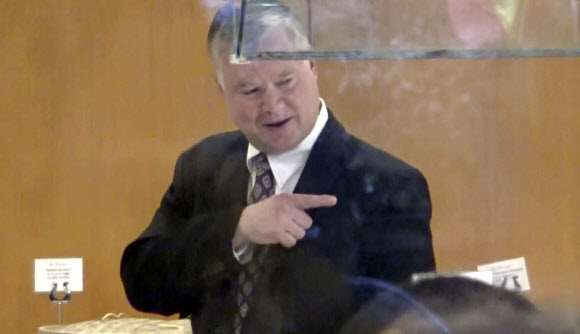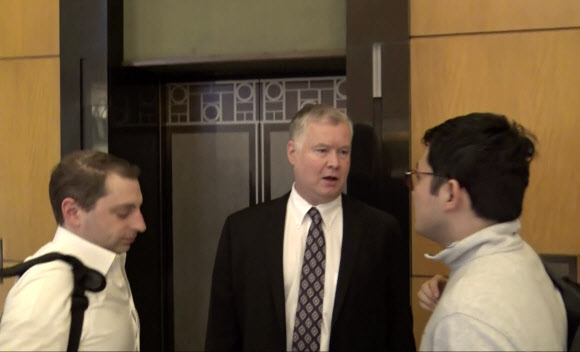Posted on : Feb.23,2019 16:01 KST
Modified on : Feb.23,2019 16:25 KST
 |
|
This image made from a video, shows U.S. Special Envoy for North Korea Steve Biegun at a restaurant in Hanoi Friday, Feb. 22, 2019. Chief negotiators from the U.S. and North Korea has reportedly been holding a meeting in Hanoi ahead of the second U.S.-North Korea summit, Japanese broadcaster TBS reports. (TBS via AP)/
|
Washington broadens scope of demands in reflection of negative domestic opinion
The US has been sending a mix of tough and moderate messages to North Korea ahead of their second summit. With working-level talks under way in Hanoi to coordinate the summit agenda, the aim appears to be a last-minute bid to increase bargaining strength while softening critical opinion at home.
What stood out in a Feb. 21 press briefing by a senior US administration official was the way it clearly spelled out which areas will be priorities at the summit. Referring to a Jan. 31 speech at Stanford University by State Department Special Representative for North Korean Stephen Biegun, the official noted that Biegun had mentioned promoting a shared understanding of denuclearization, a freeze on all WMD and missile programs, and cooperation toward a roadmap.
All of these are key themes in the denuclearization talks, but they are also areas where North Korea and the US have recently had difficulties reaching an agreement. As a result, they come across as raising the threshold just ahead of the summit. It will not be easy for the two sides to agree on how far the “denuclearization” concept is to extend. Cho Sung-ryul, a senior research fellow at the Institute for National Security Strategy, noted that the two sides “also have their differences on whether missiles should be included as part of denuclearization.” The roadmap issue is similarly vexing, since it involves working out the timeline and sequence for matching denuclearization steps with corresponding measures.
 |
|
U.S. Special Envoy for North Korea Steve Biegun, center, speaks with an unidentified man near an elevator in Hanoi, Vietnam Friday, Feb. 22, 2019. Chief negotiators from the U.S. and North Korea has reportedly been holding a meeting in Hanoi ahead of the second U.S.-North Korea summit, Japanese broadcaster TBS reports. (TBS via AP)
|
US indicates freeze must include ICBMS and other missiles
The matter of a freeze on all WMD and missile programs is a focus of particular attention. Biegun did not explicitly discuss the topic in his Stanford speech. The term “WMD” is typically taken to refer to nuclear, biological, and chemical weapons together. The US’ inclusion of the “missile program” as well comes across as a message that a freeze is also necessary for North Korean’s ICBMs and other missiles.
So far, the US has been putting major emphasis on the dismantlement of the facilities at Yongbyon, which are used to produce nuclear material. On Feb. 22, the White House once again recalled leader Kim Jong-un’s pledge to dismantle plutonium reprocessing and uranium enrichment facilities – a reference to Kim’s statement at an inter-Korean summit last September about his willingness to dismantle the Yongbyon facilities in response to corresponding US measures.
With its mention now of a “freeze on all WMD and missile programs,” the US is effectively insisting on Yongbyon plus “something extra.” The measure appears to reflect awareness of domestic opinion in the US, where many see the administration as being too conciliatory toward the North. Another apparent influence on the missile freeze issue has been the demands of Japan, which lies within firing range of North Korean missiles. But the kind of freeze the US is demanding represents a lower level than an immediate dismantlement of WMDs or their transfer outside of North Korea. In effect, Washington has broadened the scope of its demands in response to critical opinion at home, while adopting an incremental approach in practice.
Raising threshold while offering carrot of economic development
Analysts have also suggested an influence from the approaches of the Carnegie Endowment for International Peace and an expert group at Stanford, whose opinions Biegun is reported to have sought on the issue. The endowment and group have advised that denuclearization will take some time and entail a step-by-step, realistic process. Instead of complete denuclearization, the Carnegie team has suggested an intermediate stage of “complete, verifiable capping (CVC),” which could be achieved by 2020. Toby Dalton, co-director of the endowment’s Nuclear Policy Program, told the Hankyoreh, “We’ve focused on explaining the CVC plan to current administration officials since the middle of last year.”
In this way, the US has raised the threshold while also offering the carrot of economic development.
“North Korea will need to make the right choice [to denuclearize] at some point, and we’re offering every incentive so that it does that,” a senior official said.
In an announcement on Feb. 21, the White House said US President Donald Trump “has made clear that should North Korea follow through on its commitment to complete denuclearization, we will work to ensure there are economic development options.” In particular, it stressed that “[r]obust economic development under Chairman Kim is at the core of President Trump’s vision for a bright future for United States–DPRK relations.” In effect, Washington is offering both regime security and economic growth as incentives.
In an interview with NBC, Secretary of State Mike Pompeo said, “To keep the American people safe, we have to reduce the threat from a nuclear-armed North Korea.”
“And then in turn, we can work on peace and security on the peninsula and a brighter future for the North Korean people,” he continued.
By Hwang Joon-bum, Washington correspondent, and Noh Ji-won, staff reporter
Please direct comments or questions to [english@hani.co.kr]










